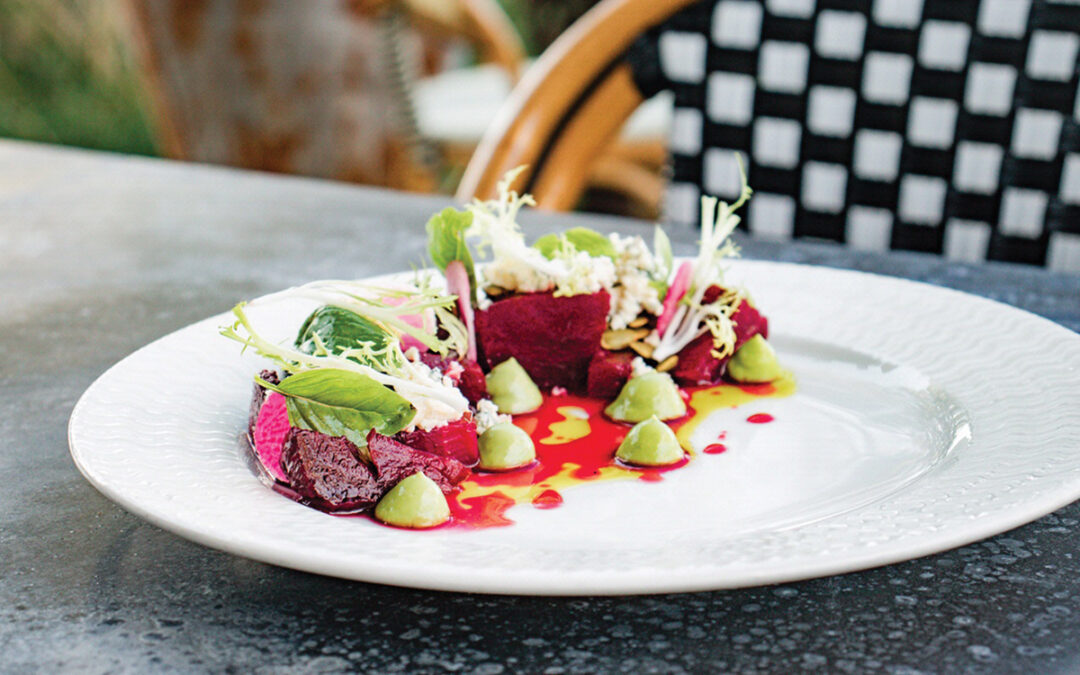In artist Marilyn Lanfear’s bedroom hangs a huge panel depicting a woman, a large old-fashioned bed and three small children. Titled Every Night She Latched All the Windows, Locked All the Doors and Put the Babies in Her Bed, the panel is based on a story Lanfear’s grandmother told her. The little boy in the picture is her father, the two little girls her aunts. Nothing very unusual about that — artists often draw inspiration from the past — but what is unique about this particular work is that the image is entirely rendered with buttons. Yes, you read it correctly — buttons, mostly genuine mother-of-pearl ones from decades past but also some made out of bone. Everything, from the woman’s dress and the children’s faces to the tile floor, is “painted” with rows of sewn buttons of different sizes and shades.
The effect is transformative. What could have been a relatively mundane drawing has been given another dimension through the use of an unorthodox medium, which at the same time is a very recognizable link to ordinary life, women’s work and early 20th-century life. Combining the image, the medium and the descriptive title, the viewer clearly gets a sense that the depicted woman fears for her own and her children’s safety, that her husband is either dead or absent; that there is a danger lurking beyond the protective walls of her home. It’s a story that resonates with a lot of people. “My grandmother lived on a farm, miles from town,” explains the artist. “This was after her husband was shot and killed while working in the oil fields. East Texas was the wild and wooly West back then, around 1904-5.”
The panel, which took three years to complete, was first shown in 2003 at the Art Museum of South Texas in Corpus Christi and again in 2007 in a group show at the Blue Star Contemporary Art Center. Lanfear also worked long and hard on a triptych of button panels she calls Uncle Clarence’s Three Wives. Once again based on family history, the three pieces also parallel the history of Texas in the first part of the last century, from the discovery of oil through WWII and back to the booming oil-drilling business.
OTHER MEDIA
Buttons are not her only medium, however. Family stories are also transformed into three-dimensional installations that, though based on real events, are abstract enough to allow the viewer to interpret them according to his own associations. A particularly eloquent one, A Mantle to Keep Him Cool/A Mantle to Keep Him Warm, recently shown at Bihl Haus Arts, featured the “tombstone” of William Weldom Moore, who died in 1913 at the age of 3. Suspended above the stone hung two items of children’s clothing made of handmade paper, and above it all stood a mantle of collard greens made of paper and silk. All of these objects were tied together by the story Lanfear engraved on the stone, about a wagon of collard greens that the children decided to play in. There were seven of them, but only little William got sick and died. “Did you know that he had blond hair and blue eyes?” “I am a visual storyteller; I make art about life,” says the petite artist, whose work has been exhibited throughout Texas and beyond. “I tell my stories with objects and a few words. I spend a lot of time condensing the text to a necessary minimum. Objects of the material culture are loaded with meaning, and what’s more, your meaning may be different from mine. I hope to touch the viewers so they’ll fill in the rest (of the story).”
The objects she uses are both the real thing or transformed in some way to fit her aesthetics. In the tale of little William, all the real-looking items were actually made by the artist in different materials than their real-life counterparts. But Lanfear also creates sculptural installations by creatively grouping together related vintage objects of all kinds that make statements of their own. These pieces tend to be smaller and more affordable. In March, the Koelsch Gallery in Houston showed a selection of them in the price range of $3,000 to $4,000. One such sculpture, for instance, consisted entirely of old wooden ironing boards, while another, a wall piece, was made from discarded church-organ parts. But the one that Lanfear was most proud of was an array of antique measuring devices displayed under glass like traditional museum specimens. That one cost $60,000.
Critics have generally praised Lanfear’s work, and just about every San Antonio art institution worth its contemporary salt has hosted her art in solo exhibitions, from the Joan Grona Gallery to the San Antonio Museum of Art and the Southwest School of Art and Craft. Altogether, she’s had 16 one-woman shows here and in Houston, Corpus, Dallas, Victoria and New York and has participated in many group events, including one in São Paulo, Brazil. She is currently thinking about her 2010 show at Blue Star.
Bihl Haus director Dr. Kellen McIntyre considers Lanfear “such an important artist who hasn’t quite yet received the full recognition she deserves.
“One of the things that makes her critically important is that she is a woman artist working from a feminine perspective but doing it in very nontraditional materials,” says McIntyre. “She deals with technical issues (of the various media) at such a high level. And when she talks about her pieces, she talks about them as if they were living beings. That comes across in her work. I think her work is just spectacular.”
ARTIST AND ACTIVIST
A native of Waco who grew up in Corpus Christi, Lanfear says she has always known she wanted to be an artist. As with so many women, however, marriage and child rearing took precedence for many years before she decided to seriously pursue her heart’s desire. She eventually earned both a B.F.A. and an M.F.A. from UTSA in 1976 and 1978 respectively. Early on, Lanfear explored drawings and watercolors, but one day in 1980 her architect brother gave her a piece of lead, which sparked an idea: “I looked at it and I said, “Oh, I’ll make a blouse out of it!'”
Not too many people would associate a piece of metal with clothing, but that momentary insight led to a series of original creations, which first exemplified her knack for transforming the ordinary while imbuing it with new meaning. Lanfear eventually made a name for herself with her lead garments — startling children’s clothes, often set on pedestals; women’s dresses complete with ruffles and lace, a battered-looking vest, etc. What the artist liked was the analogy between lead used as a shield and women’s clothes seen as social armor. One of her lead sculptures, Marilyn with No Middle Name/She Will Have One When She Marries, is owned by the McNay Museum. When her marriage fell apart in the “80s, and her four children were grown, Lanfear’s career took off. She first headed to “Mecca,” as she puts it — meaning New York City — then returned home for a while before taking a job in Portland, Ore., teaching studio art. It was while there that her fascination with buttons began.
“Wherever I go, I study the history and culture of the area. One thing that caught my eye in Oregon was that the Native Americans used buttons mainly for decoration,” she explains. “I met a woman, a member of one of the tribes, who had a robe that she would wear for tribal dancing, and at the end of the dance she would open it to reveal all these buttons on the inside. My interest was piqued. I began to collect buttons, and I decided I should do a piece with buttons about my grandmother who was a seamstress.” For several years, as she traveled back and forth between San Antonio and Portland, Lanfear would stop along the way “at every place that could possibly have buttons.” She didn’t want any “new” plastic specimens, of course; only genuine mother-of-pearl.
And buttons are hardly the only thing she collects. In her home in the quaint River Road neighborhood, a number of her collections are part of the decor, from beautifully shaped rocks to toy chairs and vintage metal boxes. Mingling with her own creations, all these objects blend harmoniously with the home’s atmosphere.
Needless to say, Lanfear spends considerable time browsing through antique and junk shops. “I have incorporated my love of shopping into my aesthetic,” she jokes.
Her aesthetic extends to her living environment as well. With her neighbors, Lanfear, an active Democrat, has fought to preserve the River Road enclave the way it is, successfully blocking an attempt by San Antonio River Improvements Project planners to direct pedestrian and bicycle traffic through the neighborhood. Today, she is just as passionate about protecting the nearby quarter-mile-long Avenue A, which stretches along the river from Mulberry Avenue to the fence that encircles the newly spiffed-up Brackenridge Golf Course.
“It’s the only part of the river that has not been ‘improved’,” she observes. “It’s a bird sanctuary and a green respite. I am fighting to save the birds.”
And her activism doesn’t stop there. She wrote to the mayor about the unceasing development over the aquifer, including the area around Camp Bullis, whose mission is being imperiled by encroaching residential and commercial sprawl.
Asked how she juggles all her interests, she looks a bit puzzled for a second before answering: “I never run out of ideas, but I do run out of time. There are so many things I would like to do, but I can’t do them all at once.”
One thing among many that she would like to accomplish in the near future is to collect enough buttons to create a new piece for her upcoming Blue Star show. If you have old buttons lying around, she’ll be happy to take them off your hands.
Author: Jasmina Wellinghoff
Photographer: Janet Rogers









0 Comments